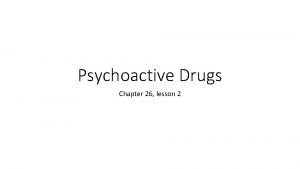Student Perceptions of Two Versions of a Campus

- Slides: 1

Student Perceptions of Two Versions of a Campus Sexual Assault Resource Guide Jazlyn Mitchell, Kathryn Becker-Blease, Ph. D. School of Psychological Science, Oregon State University Introduction University campuses market themselves as safe, but this is not always the case, 11. 2% of all students on university campuses will experience rape or sexual assault through physical force, violence, or incapacitation (RAINN, 2015) while attending school. Research has shown that the way in which institutions, such as universities, respond to violence can worsen post-traumatic outcomes (Smith & Freyd, 2013). When an institution causes harm to an individual who trust and depends on them for safety and wellbeing, it is called institutional betrayal (Smith & Freyd, 2014). Institutional betrayal can manifest itself in many ways that include denial of allegations, lack of language and awareness of issues that continually arise, and value of reputation over the well-being of it’s members to name a few (Smith & Freyd). Institutions can also become sources of justice, healing, and support (Freyd, 2014) as when Oregon State University issued a public apology to Brenda Tracey, a survivor of sexual assault, in regards to how the university treated her report almost a decade previously. Materials Discussion and Future Projects The materials that will be used will consist of the current sexual assault resource guide, created and distributed by the Oregon State Police and the Department of Public Safety, and the revised version that was edited and reviewed by a panel of undergraduate psychological researchers at Oregon State University using the Illinois Rape Myth Acceptance Scale rape myth measure. While keeping with similar framework of the original sexual assault resource guide, many things were omitted and changed. Understanding the scope and impact that institutional involvement has in traumatic events like sexual assault and rape requires a willingness to examine the ways in which a trusted institution may foster abuse and to recognize that this potential does not rest on the individual but on the system as a whole. This willingness to be aware of institutional wrongdoing is certainly growing, and the current research objective hope to contribute to this awareness. We are currently awaiting IRB approval to begin the study but we hope to begin collecting data very soon. Below, is an excerpt from the current sexual assault resource guide titled, Be Alert When With Acquaintances: If you or anyone you know has experienced sexual violence or assault, listed below both on- and off-campus resources and organizations created to support and protect survivors. http: //www. campbellsoupcompany. com/pressrelease/campbell-to-remove-bpafrom-packaging-by-mid-2017 Below, is an excerpt from the revised sexual assault resource guide titled, Sexual Assault by Acquaintances: To prevent violence, it is crucial that resources from law enforcement and university organizations accurately address sexual assault and do not encourage beliefs that perpetuate violence. The current research objective is focused on student perception of the Office of Public Safety’s current sexual assault resource information and our revised version of the content. The study is in its preliminary stages, but we eventually hope to gather evidence demonstrating that our revised version of the content better provides information regarding sexual violence prevention and awareness. We hypothesize that students, especially those who have survived an assault, will report higher institutional support after reading the revised version. Email: Kathryn. Blease@oregonstate. edu Resources and Support • Survivor Advocacy and Resource Center (541 -737 -2030) 311 Plageman Building, Student Health Services survivoradvocacy@oregonstate. edu • Counseling and Psychological Services (CAPS) (541 -737 -2131) 500 Snell Hall CAPS@oregonstate. edu • Center Against Rape and Domestic Violence (CARDV) (541 -7580219 4786 SW Philomath Blvd, Corvallis, OR 97333 • Sexual Assault Nurse Examiners (SANE) at Student Health Services (541 -737 -9355) Plageman Building studenthealth. oegonstate. edu • RAINN (Rape, Abuse and Incest National Network) 1 -800 -656 -HOPE (4673) https: //www. rainn. org References Campus sexual violence: statistics, 2016). Retrieved from https: //www. rainn. org/statistics/campus-sexual-violence Freyd, J. J. , 2014). Official campus statistics for sexual violence mislead. Retrieved from http: //america. aljazeera. com/opinions/2014/7/college-campus-sexualassaultsafetydatawhitehousegender. html Mc. Mahon, S. , & Farmer, G. L. (2011). An updated measure for assessing subtle rape myths. Social Work Research, 35(2), 71 -81. Payne, D. L. , Lonsway, K. A. , & Fitzgerald, L. F. (1999). Rape myth acceptance: Exploration of its structure and its measurement using the Illinois Rape Myth Acceptance Scale. Journal of Research in Personality, 33, 27– 68 Smith, C. A. , Freyd, J. J. (2015). Institutional Betrayal. American Psychologist 69 (6), 575 -587 Presented at Oregon State University’s Celebrate Undergraduate Excellence Symposium, Corvallis, OR. May 19 th, 2017

